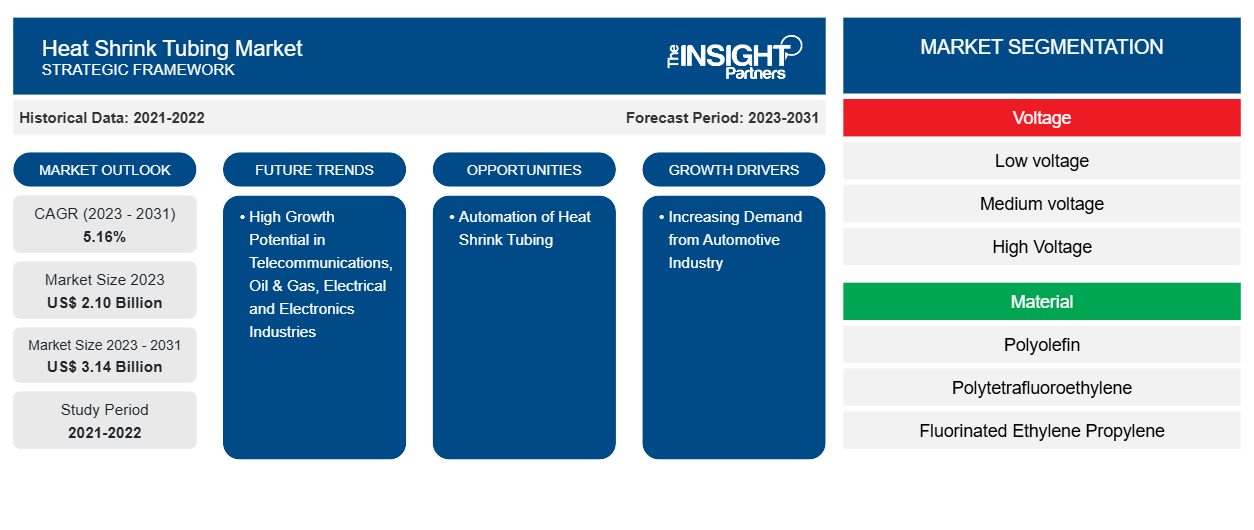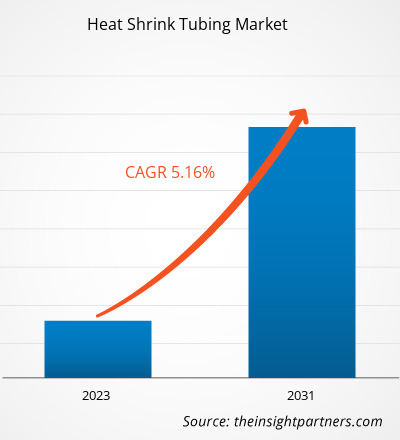The heat shrink tubing market size is projected to reach US$ 3.14 billion by 2031 from US$ 2.10 billion in 2023, with a CAGR of 5.16% by 2031. Rising demand from the automobile industry and government initiatives to upgrade transmission and expand distribution systems are among the major factors driving the growth of the market. Furthermore, high growth potential from industries such as electrical & electronics telecommunications, and oil & gas provides lucrative growth opportunities for the market. Automation of the heat shrink tubing process is expected to emerge as a trend in the market during 2023-2031.
Heat Shrink Tubing Market Analysis
The major stakeholders in the market ecosystem include raw material providers, heat shrink tube manufacturers, and customer or end-user. The raw material provider is a crucial stakeholder in the ecosystem of the market. The major parts of the heat shrink tubing include materials such as Polyolefin, Polytetrafluoroethylene, Fluorinated Ethylene Propylene, Perfluoro alkoxy Alkane, Polyvinylidene Fluoride, and Others.
Heat Shrink Tubing Market Overview
Heat shrink tube manufacturers produces the product as per the industry's requirement compatible for a wide range of applications. Heat shrink tubing companies are growingly focusing on improving battery efficiencies and range by enhancing charging infrastructure. The presence of large number of heat shrink tubing manufacturers are competing at large scale primarily based on advanced material and availability of presence across the globe. It includes 3M, Shenzhen Woer Heat Shrinkable Material Co., Ltd; TE Connectivity, and Sumitomo Electric Industries, Ltd among other players.
Customize This Report To Suit Your Requirement
You will get customization on any report - free of charge - including parts of this report, or country-level analysis, Excel Data pack, as well as avail great offers and discounts for start-ups & universities
Heat Shrink Tubing Market: Strategic Insights

-
Get Top Key Market Trends of this report.This FREE sample will include data analysis, ranging from market trends to estimates and forecasts.
Heat Shrink Tubing Market Drivers and Opportunities
Increasing Demand from Automotive Industry
With the growing trend of electric vehicles, the increasing need for wired appliances is boosting the market. Heat shrink tube in an electric vehicle is used in many applications for wire shielding from charging socket to electrical components throughout the vehicle dashboard, windscreen wiper system, lighting system, central locking system, acoustic system, air condition system, and so on.
High Growth Potential in Telecommunications, Oil & Gas, Electrical and Electronics Industries
Heat shrink tubing has various uses and is widely used within telecommunications networking cables. Heat shrink tubes are used to safeguard these connections, cables, conductors, joints, and terminals, against environmental damage. Furthermore, the oil & gas industry faces the most challenging environmental effects and conditions. Extreme heat, corrosion, pressure, and other factors affect the equipment utilized in the oil & gas industry. Heat shrink tubing makes sures the equipment delivers consistent and reliable performance. Thus, the demand for heat shrink tubing across telecommunications, oil & gas, and electrical & electronics industries provides ample opportunities for market growth.
Heat Shrink Tubing Market Report Segmentation Analysis
Key segments that contributed to the derivation of the market analysis are voltage, material, and end-user.
- Based on the voltage, the market is divided into Low voltage (Less than 5kV), Medium voltage (5-35 kV), and High Voltage (Above 35kV). The low voltage (less than 5KV) segment held a larger market share in 2023.
- Based on material, the global heat shrink tubing market is divided into below Polyolefin, Polytetrafluoroethylene, Fluorinated Ethylene Propylene, Perfluoro alkoxy Alkane, Polyvinylidene fluoride, and Others. The Polyolefin segment held a larger market share in 2023.
- Depending on the end-user, the global market is divided into Energy, Utilities, Electrical Power, Infrastructure/Building Construction, Industrial, Telecommunication, Automotive, Aerospace, Defense, Mass transit and Mobility, Medical, Petrochemical, and Mining. The utilities segment held a larger market share in 2023.
Heat Shrink Tubing Market Share Analysis by Geography
The scope of the heat shrink tubing market report encompasses North America (the US, Canada, and Mexico), Europe (Spain, the UK, Germany, France, Italy, and the Rest of Europe), Asia Pacific (South Korea, China, India, Japan, Australia, and the Rest of Asia Pacific), the Middle East & Africa (South Africa, Saudi Arabia, the UAE, and the Rest of Middle East & Africa), and South & Central America (Brazil, Argentina, and the Rest of South & Central America). In terms of revenue, APAC dominated the heat shrink tubing market share in 2023. North America is the second-largest contributor to the global heat shrink tubing market, followed by Europe.
Heat Shrink Tubing Market Regional InsightsThe regional trends and factors influencing the Heat Shrink Tubing Market throughout the forecast period have been thoroughly explained by the analysts at The Insight Partners. This section also discusses Heat Shrink Tubing Market segments and geography across North America, Europe, Asia Pacific, Middle East and Africa, and South and Central America.
Heat Shrink Tubing Market Report Scope
| Report Attribute | Details |
|---|---|
| Market size in 2023 | US$ 2.10 Billion |
| Market Size by 2031 | US$ 3.14 Billion |
| Global CAGR (2023 - 2031) | 5.16% |
| Historical Data | 2021-2022 |
| Forecast period | 2023-2031 |
| Segments Covered |
By Voltage
|
| Regions and Countries Covered |
North America
|
| Market leaders and key company profiles |
|
Heat Shrink Tubing Market Players Density: Understanding Its Impact on Business Dynamics
The Heat Shrink Tubing Market is growing rapidly, driven by increasing end-user demand due to factors such as evolving consumer preferences, technological advancements, and greater awareness of the product's benefits. As demand rises, businesses are expanding their offerings, innovating to meet consumer needs, and capitalizing on emerging trends, which further fuels market growth.

- Get the Heat Shrink Tubing Market top key players overview
Heat Shrink Tubing Market News and Recent Developments
The market is evaluated by gathering qualitative and quantitative data post primary and secondary research, which includes important corporate publications, association data, and databases. The following is a list of developments in the market for innovations, business expansion, and strategies:
- In March 2024, Materials specialist and pioneer of FEP Peelable Heat Shrink Tubing (PHST), Junkosha, unveiled its latest catheter-based innovation, the 1.8:1 shrink ratio Translucent PHST solution, at the MD&M West show from February 6th to 8th2024. (Source: Junkosha, Press Release)
Heat Shrink Tubing Market Report Coverage and Deliverables
The “Heat Shrink Tubing Market Size and Forecast (2021–2031)” report provides a detailed analysis of the market covering the following areas:
- HEAT SHRINK TUBING Market size and forecast at global, regional, and country levels for all the key market segments covered under the scope.
- Market dynamics such as drivers, restraints, and key opportunities
- HEAT SHRINK TUBING Market Trends
- Detailed PEST/Porter’s Five Forces and SWOT analysis
- HEAT SHRINK TUBING Market Analysis covering key market trends, Global and regional framework, major players, regulations, and recent market developments
- HEAT SHRINK TUBINGIndustry landscape and competition analysis covering market concentration, heat map analysis, prominent players, and recent developments.
- Detailed company profiles
- Historical Analysis (2 Years), Base Year, Forecast (7 Years) with CAGR
- PEST and SWOT Analysis
- Market Size Value / Volume - Global, Regional, Country
- Industry and Competitive Landscape
- Excel Dataset
Recent Reports
Testimonials
Reason to Buy
- Informed Decision-Making
- Understanding Market Dynamics
- Competitive Analysis
- Identifying Emerging Markets
- Customer Insights
- Market Forecasts
- Risk Mitigation
- Boosting Operational Efficiency
- Strategic Planning
- Investment Justification
- Tracking Industry Innovations
- Aligning with Regulatory Trends





















 Get Free Sample For
Get Free Sample For